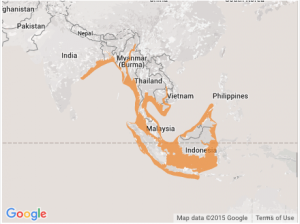About Irrawaddy Dolphins

Irrawaddy Dolphin (Curtin, 2014)
Appearance
With a distinct appearance, the Irrawaddy Dolphin is easily recognised. It has a round head, with no beak, and a forehead that extends beyond its facial features. It has distinct neck creases due to its flexible neck, and a small triangular dorsal fin with a blunt end. Its flippers are long and wide, with curver leading edges and rounded tips. The Irrawaddy Dolphin has a uniform dark blue-grey to medium grey, with a paler grey underside. It has a relatively small size.
Behaviour
Irrawaddy Dolphins are slow swimmers. They are shy of boats and are not known to bow-ride, and generally dive when alarmed. They can be seen spyhopping and rolling to one side, while waving a flipper and occasionally breaching.

Irrawaddy Dolphin spyhopping (Save Our Species, n.d.)
Irrawaddy Dolphins are capable of squirting streams of water that can reach up to 1.5m, and this distinct behaviour is known for herding fish into general area for hunting and feeding. The typical family unit contains up to 6 individuals, but sometimes as many as 25 individuals have been known to gather in deeper pools.

Irrawaddy Dolphin squirting water (World Wildlife, 2014)
Habitat and Distribution
Irrwaddy Dolphins live in both salt and freshwater, and are found in coastal areas in South and Southeast Asia. There are 5 exclusive freshwater populations: the Ayeyarwady River (Myanmar), the Mahakam River (Indonesian Borneo), the Mekong River (Laos, Cambodia, Vietnam), the Songkhla Lake (Thailand) and the Chilka Lake (India). They prefer deep pools of large rivers, sheltered inshore marine waters with substantial freshwater inputs such as mangrove swamps and lagoons, or partially isolated freshwater bodies.

Distribution of Irrawaddy Dolphins (World Wildlife, n.d.)
Biggest Threat
Irrawaddy Dolphins are principally and severely threatened by very high fisheries by-catch rates. Habitat destruction and loss is increasingly threatening to their survival as well. Their ideal habitats bring Irrawaddy Dolphins into very close contact with many human activities. Constructions of dams have dramatically and significantly reduced the natural range of the freshwater populations, hastening their extinction. Furthermore, the relatively small size of the Irrawaddy Dolphins and their ability to spit water has unfortunately made this species increasingly popular in captivity.
Status

(IUCN, 2004)
The IUCN listed the Irrawaddy Dolphin as Critically Endangered.
To date, about 70-85 individuals live in the Mekong River, about 60 live in the Ayeyarwady River, about 35 live in the Mahakam River, and very small numbers surviving in the Songkhla and Chilka Lake.

Leave a Reply